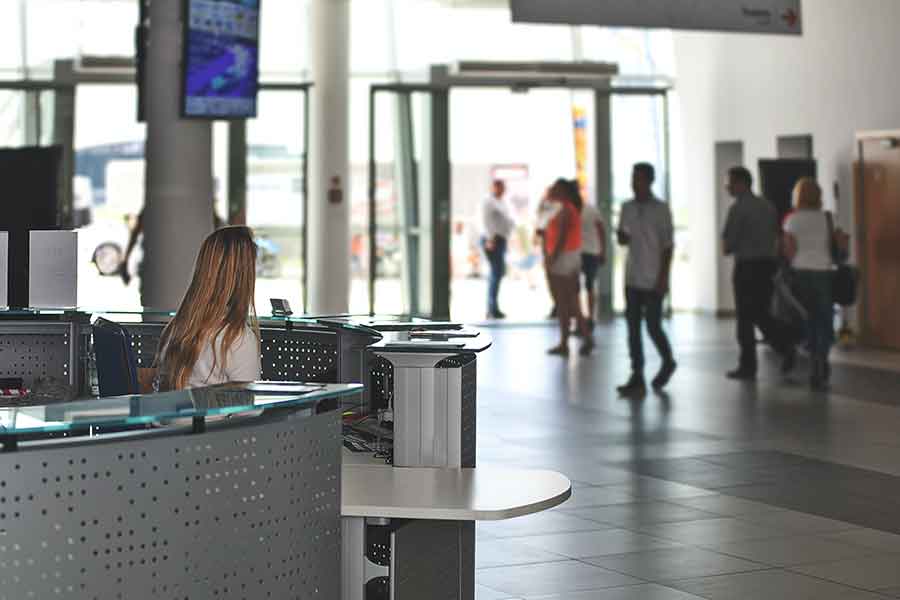Commercial Audit Case Study
Highrise Building in Buckhead, GA
Knight Protection Services worked with a property management company of a highrise (class A building) in Buckhead to help them through a liability issue. This article will take you through the design and planning phase and then the implementation of their improved security.
Taking proactive steps into creating a safe workplace and environment are some of the most important aspects of leadership and security.
The Problem:
Located in the uptown commercial and residential district of the city of Atlanta, this building has 20 or more floors with dozens of clients and tenants on each of the floors. The bottom floor housed a busy restaurant that was frequented by many patrons throughout the day. The problem arose when the restaurant had a fire in the kitchen. The alarm went off as the fire spread beyond the kitchen, however most of the tenants in the building actually had no idea the alarm was sounding. As other tenants began notifying each other, over 300 people ended up trapped in the stairwell through all of the confusion. Whether a poor evacuation plan or poor response plan in general, our client was facing liability and negligence in their response to this emergency.
One of the primary concerns the management company is now facing is the lack of response by their contracted security company. Knight Protection Services spoke with several of the guards as well as the CEO of the company to find out his typical working environment. What was found was that the security team and the management team had their own policies. The security team usually integrates their policy and response procedures, but the management team had their own policy that wasn’t communicated and implemented properly. The problem was confusion in the response plan between the security company’s and the management team.

Our client was not only concerned with their response to a fire, they also wanted to look beyond that into other areas of concern. We are experts in finding the missing piece to their security puzzle. As we conducted a full security assessment on their premises, we found several other shortcomings that were not being tracked appropriately.
- There were several access-controlled doors that we found propped open allowing easy access to several secure areas.
- There was no check point system for the security team to monitor where they are patrolling, which would help avoid doors being propped open for extended periods.
- Lack of and improper lighting in different areas of their property. This is a serious concern during limited visibility hours, especially for those highly motivated employees that get to work early and stay late. We partially addressed this with improved lighting across the property
- Landscaping around the buildings – proper sight lines are important for several reasons, for instance, being able to see who is coming into the building is a huge aspect of security. The building has a security guard stationed in the lobby, but they were unable to see into the front approach area due to overgrown shrubbery across the front of the building. There was also overgrown shrubbery bordering the parking garage, leading to easy hiding spots for criminal intent.
- One of the largest issues that the client (the property management company) notated was the inability to communicate with each other and with their clients. Having great policy and procedures in place for a business is an awesome first step; unfortunately, without practicing emergency response, there will never be fluidity in helping clients during an emergency. Being on the same page is incredibly important during emergency incident responses.
The Solution:
Once we were retained for their security audit, we found several pressing matters that needed to be addressed. Several of the issues involved the property management company’s communication and the lack of leadership that was present within the organization. One of the biggest problems was their expectations and the lack of connecting that mission to the contractors that they hired to help with the property. Our goal was to get every person on the team on the same page and help them understand the value of teamwork and how every department was a part of the solution.
Step 1
The first step in our process is to determine the asset that needs to be protected. In this case it was easily identifiable as the clients and customers that are frequenting the location. This adds up to be thousands of people very day that the management company is responsible for.
Step 2
The second step in the process is to determine what threats are present. In this case there are two key threats that we wanted to look at: failure to evacuate and failure to communicate.
Step 3
The third step is that we identify vulnerabilities that are present for our client.
Step 4
Finally, we provide recommended actions the client should take and then help the client implement whatever measures they agree to.
The first issue I wanted to tackle was the lack of communication and several different situations of people not being on the same page. This was fixed by creating a centric policy and then implementing several drills for the entire team because everyone should have a role in fire response. Now, the management team, security team and facilities team all know how to respond during a fire and understand their roles in emergency situations. On top of that, they expanded their use of portable radios and allowed us to train floor guardians that are responsible for dictating lockdown measures and evacuation measures.
Secondly, we did not want to stop with just the operation inefficiency that they exhibited. The client wanted to go in-depth and really see what limitations their safety and security had. This is where the remainder of the vulnerability assessment came in to play. We look at every aspect of physical and cyber security from lighting to sight lights, from networks to personnel. Several of the issues we found were pretty disconcerting for the property management’s clientele.
As previously mentioned, one of the largest areas of concern was the parking garage and front entrance area to the building. This included poor lighting, lack of safety throughout the garage and poor sight lights. The majority of this was corrected by replacing lighting with L.E.D. and a different finish paint that reflects light better. We also rearranged the landscaping so that the sight lines of the security team were more open, and they could see through the parking garage as well as around the front entrance area. We also implemented better security patrol protocols and policies that allowed the guards to be more involved more often in the parking garage.
Finally, we brought all of the steps together with continued training and education. Many times, new policy and procedures have a shelf life where they are taught and then forgotten just as quickly. Most people learn much better through practical application of exercises and repetitions.
Training Program With Interactive Drills
We implemented a quarterly training program with this client because they were dedicated to not having this form of accident occur. The training program involved classroom portions where techniques and policy improvements were taught. We also expanded the training into drills that everyone participated in. We had several different drills associated with each quarter’s focus. For instance, one quarter we were focused on active assailants inside the building, while the next quarter we discussed active assailants outside the building and how to re-evacuate everyone back into the building.
This showed to be extremely successful and clients started to take notice. The property manager reports back to me frequently about how many clients mention to her about the involvement of the staff and the overall safer environment they feel they have. But what about the bottom line?
Having an overall safer environment is great, but at what cost? This is a common question that we get and initially, yes, it is an investment. Many times, we discuss how the prevention of liability and negligence claims pays for the service. And this is true, how well would your business survive a negligence claim, both financially and with your reputation.
Savings of 17.5% Annually on Insurance
But even that doesn’t speak to everyone. So the bottom line: with all of this in place you reduce retention costs which add up to being twice the employee’s salary if they leave and you have to retrain someone new. But that can still be intangible to an extent. The best part of completing all of these upgrades for this client? 17.5%! That is the savings for this client on their annual insurance premium.
For our client, that was over 6 figures in savings, which means in the first year alone, the audit and implementation paid for itself. The next year? Nothing but a better bottom line.
If lowering negligence, lowering liability, lowering retention costs AND lowering insurance premiums all appeal to you and the culture you want to build in your organization, make sure to reach out and let us know! Call Call (404) 771-9368 to learn more.



